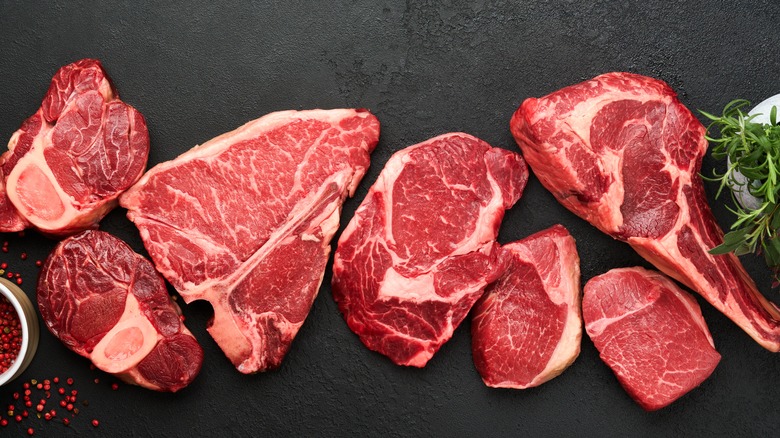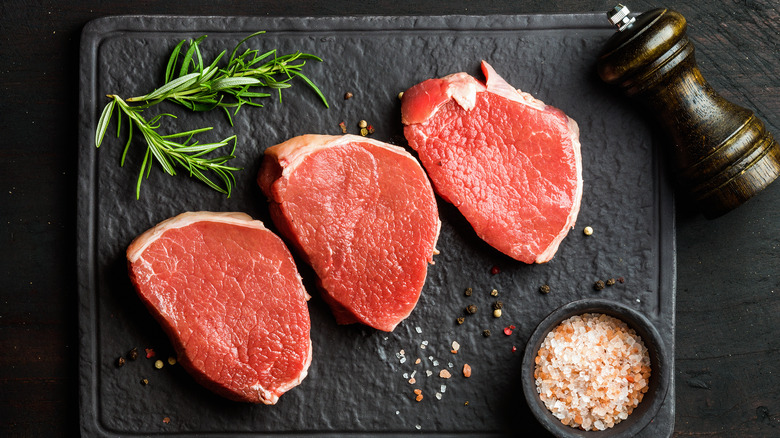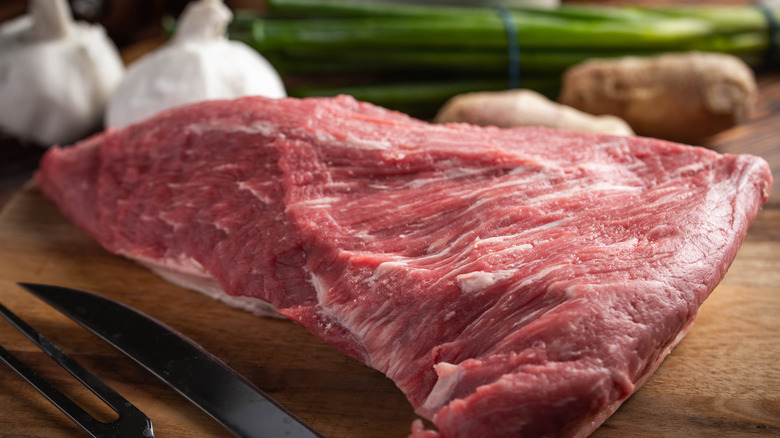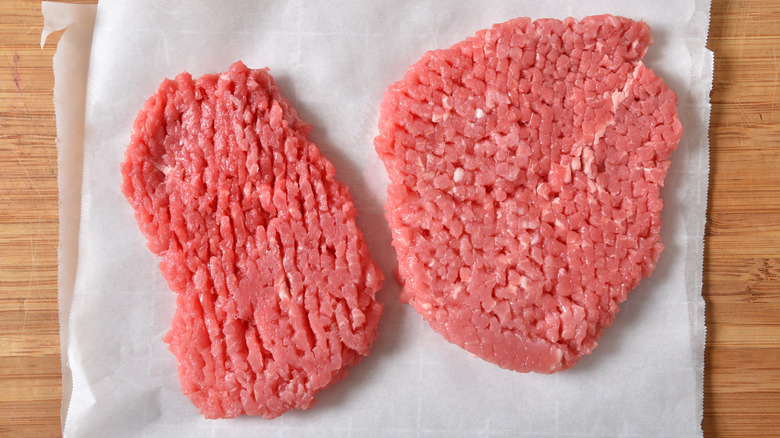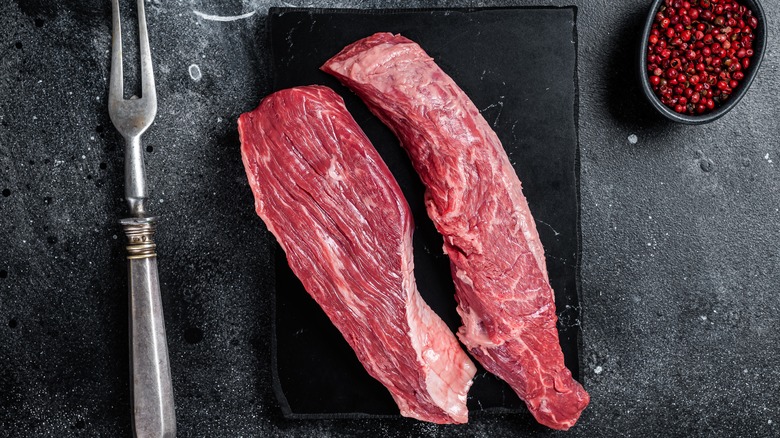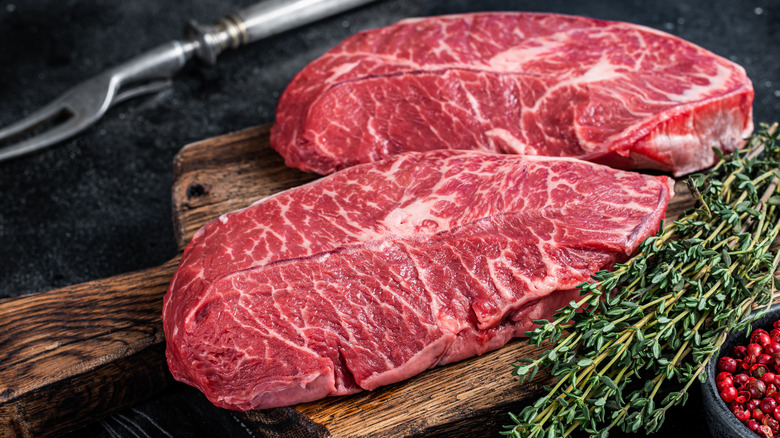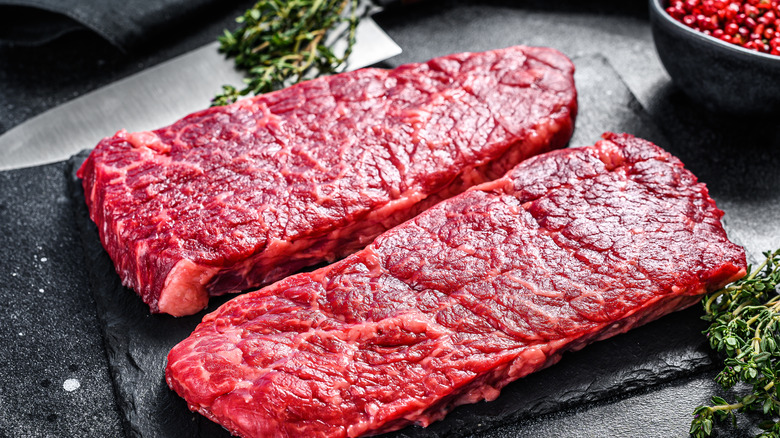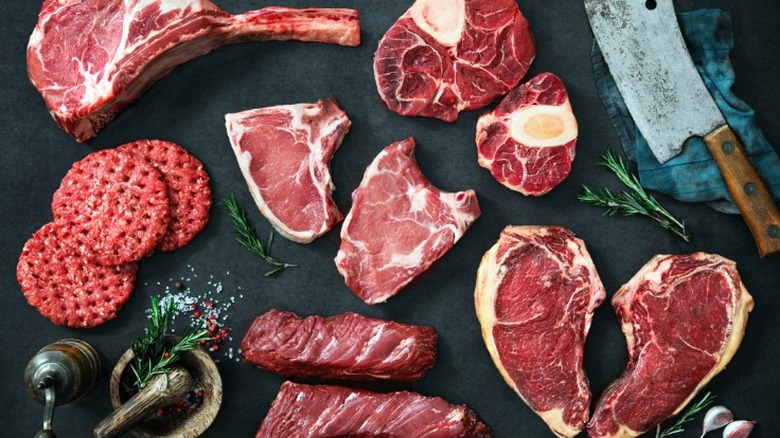The 6 Cuts Of Steak You Should Steer Clear Of Buying
It can be difficult not to get overwhelmed at the meat counter these days, especially when trying to decide what cut of steak you should or shouldn't buy. It's easy to just grab whatever steak is cheapest or the one that matches a familiar name from the last steakhouse commercial you heard on television. While turning any cut of steak into something edible is by no means impossible, there are some cuts of steak you really should steer clear of unless there are no other options available.
When choosing which cut of steak to buy, it's first and foremost important to remember to check the meat's official USDA beef grade, as steak cuts marked "Prime" or "Choice" will nearly always yield tastier results than lower-graded beef steaks. While your own location may influence the availability (and therefore the prices) of the cuts below, as much consideration as possible has been given to the typical cost, flavor, and cooking skill needed when determining what cuts of steak can safely be ignored while preparing for your next cookout or family dinner.
Eye of round steak
If you ever come across a slab of meat labeled "round steak" (or "eye of round," as it is sometimes known), you can feel free to ignore it completely. The round steak, while often cheaper than most other beef cuts, is one of the worst but most popular cuts of steak for a reason — it's lean and tough, lacking in flavor, and can easily be mistaken by someone uninformed or in a hurry for the top round. This would lead to a disappointing dinner revelation later on. Cows exercise the eye of round a lot, and unfortunately, the most flavorful cuts are those parts of the body that get the most rest.
Unlike the top round cut of steak, which is (a bit) more tender, eye of round steaks have few redeeming qualities. Both sound similar and come from the same general hind leg portion of the beef, but it is worth remembering that according to the USDA, there are "six major sections" round cuts can be divided into. Round steak, when it is made out of the eye of the round or the bottom round, is undeniably the least appetizing out of all of them. The only positive it can boast is that it is often cheaper than most other cuts of steak, but even this is not always the case.
Tri-tip steak
The tri-tip is another cut of steak that should be avoided for anyone who is averse to micromanaging their food prep. Also known as a California cut, Santa Maria steak, or "poor man's brisket" by some, the tri-tip comes from the bottom sirloin and contains a bit more marbling than either the skirt steak or the round steak cuts. Its unique triangular shape makes it quite difficult to evenly cook. Because of this, the best grilled tri-top steak recipes always call for turning the meat often while it is on the grill. Unfortunately, it is still easy to overcook the edges even while the center of the tri-tip remains rare.
Tri-tip cuts of steak also contain one of the worst qualities of skirt steaks: a grain that needs to be sliced through properly for the meat to remain as delicious as possible. It has a tendency to become tougher and chewier than normal when overcooked. Tri-tip may also be more difficult to procure, depending on your region. Those living closer to California, the tri-tip steak cut's state of origin, will likely find it easier to acquire than those on the eastern coast of the U.S. and elsewhere.
Cube steak
It's no surprise that at the time of writing, the current top "People also ask" result once you've Googled this cut is, "How do you cook cube steak so it's not tough?" Sometimes, you don't. Even though most cube steaks you find in the store have already been through a mechanical tenderizer, it can be a very difficult cut of beef to get right. This is because cube steak comes from the round (it can be made of top or bottom round, an inconsistency that also marks it down). Overall, it is a leaner cut of beef with less fat and more muscle.
Sometimes called "Swiss steak" or "minute steak" outside of the United States, cube steak is easily identifiable because of the holes that come from the tenderization process. Unfortunately, these same holes make it so the meat doesn't retain its juices while cooking as well as it should. Most cube steak instructions will call for extra liquid or generous amounts of gravy, but if you don't have any other cuts of steak available, the best thing to do would be to find a good chicken-fried steak recipe and give the meat as much lift as possible.
Bavette steak
Also known as flap meat or flap steak, bavette steak cuts can sometimes be mistaken for flank or skirt because of its odd shape. However, it can have a similar flavor to both. It comes from a deeper, less exercised area of the beef than flank and skirt cuts do and is much more tender as a result. Bavette steak can be difficult to find whole, however, and because of its unique texture, you'll probably want to avoid buying cuts of flap steak strips.
A big reason to avoid buying this cut of steak is because to cook a bavette steak properly, you have to ensure it isn't rare. It's fussy and may be a turn-off for red meat lovers. Flap meat has a mushy texture when cooked rare due to the location of the cut, the fat content, and the wide grain of the beef. If you like red meat and charred exterior, save your money for a cut that's thick enough to get a friable texture while staying red. Cooking your bavette steak to at least a medium-rare temperature can achieve a much better texture and mouth feel. It's still important to use high heat to get a good sear, but you're going to cook it longer than usual, and it also requires marinating the bavette steak ahead of time.
Blade steak
When deciding what cuts of steak to avoid buying at the grocery store, it's important to remember the entire family's food habits. Blade steak is one choice that might not be appreciated by younger members of the household. Named for a big vein of gristle that runs down the middle of the beef, blade cuts come from the same part of muscle as flat iron. It's a more affordable cut of steak, thanks to said gristle, but it takes a lot of more to cook and doesn't offer as much versatility because of this. While blade steak is more often smoked or braised, it is possible to grill a blade steak with some prep work.
If you are going to grill a blade steak, the best thing you can do is slice out the line of gristle inside the meat first. This obviously gives the meat more taste appeal, but it also prevents one edge of the steak from becoming over-tough. When butchered and cooked to the proper temperature (no higher than medium rare), blade steak can be one of the more tender cuts of steak available. If you fail to remove the gristle ahead of time and cook blade steak any higher than medium, however, your jaw muscles won't appreciate it.
Denver steak
Denver steak is a hard-to-find steak cut that is normally only available online or if you let your butcher know you want one beforehand. If you do end up finding Denver steak in a grocery store, it will likely be overpriced due to the complicated nature of extracting it. Denver steak cuts come from deep within the chuck and are extracted from the beef as a single piece, requiring a technique that takes a careful, attentive hand. Not every person cutting steaks has the level of artistry it takes to cut a Denver steak.
After much effort just to create the steak cut, if you do end up with a Denver steak, it needs to be cooked and sliced appropriately to ensure it remains tender. Because of the high amount of marbling, the best way to handle these cuts of steak is either with a low heat followed by a reverse sear or a sous vide. Just remember that even when cooking a steak sous vide, it is important to get a good sear on it at the end, and never forget to slice against the grain when serving to preserve the butcher's hard work.
Methodology
When determining what cuts of steak to avoid buying, a lot of consideration was given to the rising cost of meat prices versus the amount and quality of meat that each cut — when actually turned into a steak at home — ultimately delivers. Along with assessing value, we considered an individual cut's composition, from marbling to average density.
Our selections were done through research of popular supermarkets, both local and online butchers, consumer reviews, and from the writer's personal experience as a former chef of nearly two decades. Anything can be made delicious with the right technique and equipment, but some steaks are always going to be more appealing to home cooks than others.
